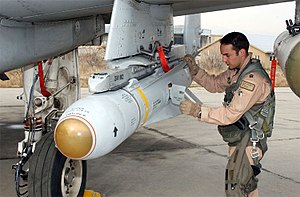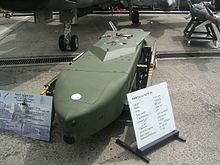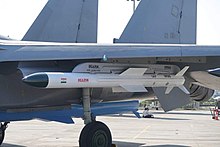Air-to-surface missile



An air-to-surface missile (ASM) or air-to-ground missile (AGM) is a missile designed to be launched from military aircraft at targets on land or sea. There are also unpowered guided glide bombs not considered missiles. The two most common propulsion systems for air-to-surface missiles are rocket motors, usually with shorter range, and slower, longer-range jet engines. Some Soviet-designed air-to-surface missiles are powered by ramjets, giving them both long range and high speed.
Guidance for air-to-surface missiles is typically via laser guidance, infrared guidance, optical guidance or via satellite guidance signals. The type of guidance depends on the type of target. Ships, for example, may be detected via passive radar or active radar homing, which is less effective against multiple, small, fast-moving land targets.
There is some cross-over between air-to-surface missiles and surface-to-surface missiles. For example, there was an air-launched version of the Tomahawk missile, superseded by the AGM-86 ALCM. Other missiles used in both roles include the Penguin and AGM-84 Harpoon anti-ship missiles. Many air-to-surface missiles can be used against both ships and land targets, although some must be modified to perform a different role; for example, the AGM-84E Standoff Land Attack Missile is a land-attack version of the Harpoon.
A major advantage of air-to-surface missiles for ground attack by aircraft is the standoff distance they provide: missiles can be launched from a distance without coming within range of the target's air defences. Most air-to-surface missiles are fire-and-forget from a standoff distance, allowing the attacker to withdraw without approaching further after launch. Some missiles (typically cruise missiles or anti-ship missiles) have long enough range to be launched over the horizon, finding the target autonomously.
Sub-categories of air-to-surface missiles include:
- air-launched anti-tank guided missiles (typically launched from helicopters)
- air-launched cruise missiles
- air-launched anti-ship missiles
- anti-radiation missiles
Typically, the higher and faster the launching aircraft is flying, the longer the reach of a particular missile is. For long-range missiles this difference can be relatively small, but short-range missiles (like the AGM-65 Maverick) have a much longer range when launched at altitude.
There have been examples of air-launched ballistic missiles (Air Launched ICBM, GAM-87 Skybolt), but they are rare. Sometimes air-to-surface missiles are divided into the categories of tactical and strategic. Typically missiles with chemical explosive or small nuclear warheads are classed as tactical, and large nuclear warheads as strategic.
List of air-to-surface missiles
Yemen (Houthi)
Japan
Argentina
Brazil
- MAR-1 anti-radiation missile
- FOG-MPM Fiber Optics Guided Multiple Purpose Missile.
- AVTM-300 Cruise missile.
China
- C-101
- C-601
- C-602
- C-611
- C-701
- C-704
- C-705
- C-801
- C-802
- C-805
- Changfeng (missile) (Chang Feng 1)
- Changfeng (missile) (Chang Feng 2)
- DH-10
- FL series (missile)
- FL-8
- FL-9
- FL-10
- FL-7
- HJ-8
- HJ-9
- HJ-10
- HJ-73
- HN-1
- HN-3
- HN-2
- HY series
- KD1 (missile)
- KD2 (missile)
- KD-63
- KD-88
- LMD-002 (missile)
- LMD-003 (missile)
- Sky Arrow (missile)
- Sky Arrow 90
- SY series (missile)
- TBI (missile)
- TL-6
- TL-10
- YJ-12
- YJ-22
- YJ-62
- YJ-63
- YJ-82
- YJ-83
- YJ-91
- ZD1 (missile)
France
- AS.11
- AS.12
- AS.15TT
- AS.20
- AS.30
- AS.30 TCA
- AS.30 Laser
- AS.37 Martel
- ARMAT
- HOT
- Exocet
- Mistral
- SCALP EG
- TRIGAT LR
- Apache
- ASMP
- ASMP-A
- AASM
- MMP
- ANL
Germany
- Taurus KEPD 350
- ARMIGER
- PARS 3 LR
- HOT (missile)
- AS.34 Kormoran
- RBS-15 (in cooperation with Sweden)
Greece
India

- BrahMos (in service)
- HeliNa/Dhruvastra (user trials)
- SANT (under development)
- Rudram-1 (in service)
- NASM-SR (under development)
- NASM-MR (under development)
- CATS Hunter (under development)
Israel
- Popeye (missile)
- Nimrod (missile)
- Rampage (missile)
- SkySniper
- Delilah (missile)
- Sea Breaker (missile)
- Air lora
- Luz (missile)
Iran
Norway
Pakistan
South Africa
- Denel ZT3 Ingwe laser guided anti-tank guided missile
- Denel Mokopa air-to-ground missile
- Kentron TORGOS air launched sub-sonic cruise missile (development cancelled)
- Denel Small Guided Missile (in development)
Sweden
Taiwan
- Hsiung Feng II (Its air-launched variant has been tested successfully, but it never entered service.)
- Hsiung Feng III
- Sky Sword IIA anti-radiation missile
- Wan Chien
Turkey
- Cirit
- UMTAS
- MAM (Smart Micro Munition)
- SOM (Air-Launched Cruise Missile)
- Akbaba Anti-radiation missile (Currently in development)
- TUBITAK-SAGE KUZGUN (Modern Modular Mutual Cost-effective Munition)[1][2]
- KUZGUN-TJ: Turbojet-powered variant.
- KUZGUN-SS: Gliding variant.
- KUZGUN-KY: Solid fuel rocket-powered variant.
- BOZOK: Mini version of KUZGUN, specifically designed for UAVs.
United Kingdom
- Blue Steel missile
- Brimstone missile
- Green Cheese missile (canceled in 1956)
- ALARM
- Storm Shadow
- BAe Sea Eagle
- GAM-87 Skybolt (air-launched ballistic missile; canceled)
- Lightweight Multirole Missile
- SPEAR 3
United States
- AGM-12 Bullpup (no longer in service)
- AGM-22 (project ceased in 1980s, still in limited use)
- AGM-28 Hound Dog (no longer in service)
- AGM-45 Shrike (no longer in service)
- AGM-53 Condor (project cancelled)
- AGM-62 Walleye (no longer in service)
- AGM-63 (project cancelled)
- AGM-64 Hornet (project cancelled)
- AGM-65 Maverick (in service)
- AGM-69 SRAM (no longer in service)
- AGM-76 Falcon (project cancelled)
- AGM-78 Standard ARM (no longer in service)
- AGM-79 Blue Eye (project cancelled)
- AGM-80 Viper (project cancelled)
- AGM-83 Bulldog (project cancelled)
- AGM-84 Harpoon (in service)
- AGM-86 ALCM (in service)
- AGM-87 Focus (no longer in service)
- AGM-88 HARM (in service)
- AGM-112 (reserved when program renamed GBU-15)
- AGM-114 Hellfire (in service)
- AGM-119 Penguin (in service)
- AGM-122 Sidearm (no longer in service)
- AGM-123 Skipper (out of service/no longer in service)
- AGM-124 Wasp (project cancelled)
- AGM-129 ACM (no longer in service)
- AGM-130 (no longer in service)
- AGM-131 SRAM II (project cancelled)
- AGM-136 Tacit Rainbow (project cancelled)
- AGM-137 TSSAM (project cancelled)
- AGM-142 Have Nap (in service)
- AGM-153 (project cancelled)
- AGM-154 JSOW (in service)
- AGM-158 JASSM (in service)
- AGM-159 JASSM (project cancelled)
- AGM-169 Joint Common Missile (project cancelled)
- AGM-176 Griffin (in service)
- AGM-X[3][4][5][6][7] (in development)
- Small Advanced Capabilities Missile (SACM) (in development)
- Bold Orion (prototype)
- GAM-87 Skybolt (air-launched ballistic missile; project cancelled)
- High Virgo (prototype)
- Hypersonic Air-breathing Weapon Concept (in development)
- AGM-179 JAGM (in development)
- AGM-183A ARRW (project cancelled)
- LRSO (in development)
USSR/Russian Federation
- Hermes-A
- Kh-15 (NATO: AS-16 Kickback; Russian: Х-15)
- Kh-20 (NATO: AS-3 Kangaroo)
- Kh-22 (NATO: AS-4 Kitchen; Russian: Х-22)
- Kh-23/Kh-66 Grom (AS-7 Kerry; Russian: Х-23 Гром, "Thunder")
- Kh_25ML (NATO: AS-10 Karen; Russian: Х-25)
- Kh_25MP (NATO: AS-12 Kegler; Russian: Х-25)
- Kh-28 (NATO: AS-9 Kyle; Russian: Х-28)
- Kh-29 (NATO: AS-14 Kedge; Russian: Х-29)
- Kh-31[8] (NATO: AS-17 Krypton; Russian: Х-31)
- Kh-32 (Russian: Х-32)
- Kh-35 (NATO: AS-20 Kayak; Russian: Х-35)
- Kh-38 (Russian: Х-38)
- Kh-45
- Kh-47M2 Kinzhal (AS-24 Killjoy; Russian: Х-47M2 Кинжал, "Dagger")
- Kh-55 (NATO: AS-15 Kent; Russian: Х-55)
- Kh-58 (NATO: AS-11 Kilter; Russian: Х-58)
- Kh-59 Ovod (NATO: AS-13 Kingbolt; Russian: Х-59 Овод, "Gadfly")
- Kh-59M Ovod-M (NATO: AS-18 Kazoo)
- Kh-80 (NATO: AS-19 Koala)
- Kh-90 (NATO: AS-X-19 Koala)
- KS-1 Komet (NATO: AS-1 Kennel)
- KSR-2 (NATO: AS-5 Kelt)
- KSR-5 (NATO: AS-6 Kingfish)
- K-10S (AS-2 Kipper)
- R-82
- S-5
- S-8
- S-13
- S-24
- S-25
- 9K114 Shturm (NATO: AT-6 Spiral)
See also
- Surface-to-air missile
- Laser-guided bomb
- Anti-tank guided missile
- Anti-ship missile
- Cruise missile
- Anti-radiation missile
- Anti-surface warfare
- Air-to-ground weaponry
References
- ^ "Kuzgun Modular Joint Ammunition Developed by TÜBİTAK SAGE Displayed". RayHaber | RaillyNews. 2021-08-17. Retrieved 2021-08-17.
- ^ "KUZGUN Modular Munition Family at IDEF 2021" (in Turkish). 2021-08-17. Retrieved 2021-08-17.
- ^ "USAF reveals slimmed-down SACM air-to-air missile concept". Flightglobal.com. 2016-02-25. Retrieved 2018-10-18.
- ^ "Raytheon selected to deliver next-generation tactical air-to-air missile solutions | IHS Jane's 360". Archived from the original on 2016-09-01. Retrieved 2017-03-26.
- ^ "Raytheon to research tactical missile capabilities".
- ^ "Textron explores capabilities for next-generation GBU-X munition". 19 November 2015.
- ^ "Small Advanced Capabilities Missile - Cord Master Engineering". 29 February 2016.
- ^ "Next Gen Kh-32 ant-ship cruise missile tests drawing to a close in Russia".
External links
- EADS - Cassidian division - Products
- DIEHL Defence: Guided Missiles
- Israel Military Industries Ltd. - Air-to-Ground Ammunition Archived 2013-05-23 at the Wayback Machine
- Kongsberg Gruppen
- Lockheed Martin - JASSM
- MBDA missile systems - solutions
- NTI.org - HiWING Mechanical & Electrical Technology Corporation
- Royal Air Force - Long Range Air-to-Surface weapons - Brimstone
- Raytheon Company - AGM-65 Maverick missile
- SAAB Group - Weapon systems
- TAURUS Systems GmbH
